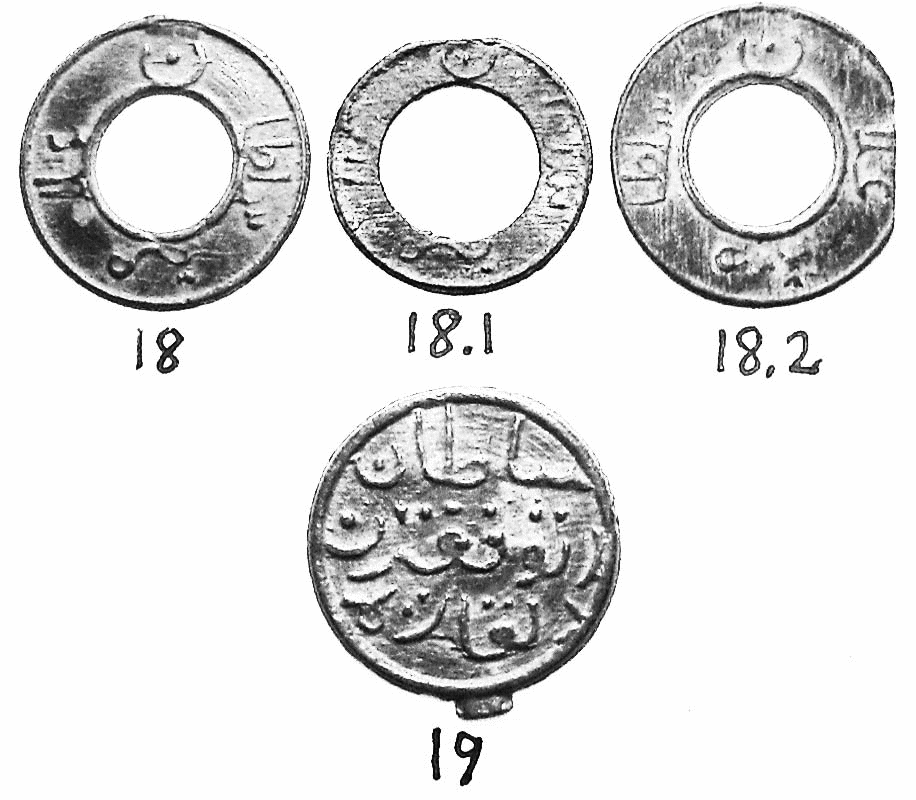
PALEMBANG COINS
By Frank S. Robinson
frank@fsrcoin.com
Palembang is one of the oldest cities in Indonesia, located on the island of Sumatra, by the Musi River. An independent sultanate, it underwent encroachment by the Dutch East India Company, cornering the lucrative spice trade. In 1821, the Dutch consummated their control of Palembang -- ending the local sultanate coinage.
The coins, starting in the 1400s, denominated “pitis,” were cast, in tin alloyed with lead (except for one bronze issue), uniface, and generally inscribed in Arabic script. (Palembang’s language is a version of Malay.) None has a ruler’s name. Dating is by the Islamic calendar, which began in 622 AD with Mohammad’s Hijra (thus “AH” [“After Hijra”] dates); the year is shorter than in the Western calendar. (To convert, subtract 3% from the AH date and add 622.)
Palembang coins are discussed in an 1871 book by H.C. Millies, in French, Recherches sur Les Monnaies des Indigenes de L’Archipel Indien et de la Peninsule Malaie, on pages 110-17; Plate XIX illustrates 28 varieties. A very similar array of 29 Palembang coins appears on Plate XXIII in Munten van Nederlandsch Indie, by Netscher and van der Chijs, published in 1863, in Dutch. Krause’s Standard Catalog of World Coins lists precisely one type (KM1, the AH 1219 issue; there is also a “KM2” whose description appears identical, but a prior edition shows it as the same coin in a smaller size). Mitchiner listed a few; Craig also listed a few, none illustrated.
Coins were cast in “trees,” then broken off the trunks. It is common to find a remnant of the stem that attached the coin to the trunk. Many of the coins are well-made, even elegant; others, not so much. It seems the degree of care employed was variable. (There are often “wood-grain”-like striations, probably due to deteriorated molds; also incomplete flans). Many coins, too, were “unofficial,” with quality even more problematic. Millies talks of coins being produced privately with the permission of the sultan, but also of hands cut off for unauthorized enterprise.
Millies says the coins with central holes were called “pitis teboh,” and unholed ones “pitis bountou.“ The value was very small, the holed coins probably trading in strings (as were Chinese cash), the unholed ones in standardized boxes, of 250 or 500 coins each, with (again according to Millies) 16 boxes equal to one Spanish Eight Real coin. This explains the crudeness of some unofficial coins (and even ones actually made featureless) – small low value coins within strings or boxes would not have been examined too carefully. (Analogously, America’s smallest coin, the silver three cent piece, was likewise much counterfeited, with stylistic discrepancies not being apparent to a casual glance.)
Until now at least, none of these coins could really be considered common, inasmuch as (based on my experience collecting world coins for half a century, and as an active dealer for most of that time) they very rarely turned up in normal numismatic commerce, especially outside the region of origin. Although they must have been produced in significant quantities, the tin coins, once they ceased to have commercial value, and lacking much scrap value, were probably mostly just dumped. And in fact, the hoards that provided the basis for this catalog (totaling about 35,000 pieces) were reportedly recovered from the Musi River by local divers. As such recent finds are dispersed by numismatic dealers, the scarcity should diminish.
Study of the mentioned hoards turned up many more variations than are catalogued in the nineteenth century books, which is what prompted this work. I will not always try to distinguish official from non-official issues – while many coins are clearly barbarous (and surely unofficial), many fall into a grey area, and whether a coin was “counterfeit” is largely a moot point. All will be catalogued here, excepting only idiosyncratic clearly barbarous varieties with individually minuscule populations. However, note that collectively, such pieces are common.
Which still leaves the question of what, exactly, constitutes a variety meriting consideration. “Die varieties” and stylistic differences that are minor will not be included; seasoned and sagacious judgment will be employed to list those exhibiting material differences of which a numismatist might wish to take note.
The main, basic types will be given integer numbers (1, 2, 3 etc.); variations will be numbered using decimals (1.1, 1.2 etc.). These should be cited as Robinson numbers, to confer some immortality on the author. The photos are of actual coins, enlarged for clarity, so be mindful of the true diameters given in millimeters (“mm”). Note that coins so well preserved are not the norm; naturally the best examples were chosen for illustration. Also, it's not always obvious (to Western eyes) "which end is up;" I will orient the coins as seems fitting to me, arbitrary though it may be.
Rarity ratings, from R1 (lowest) to R10 (highest), will be assigned based on numbers found in the hoards; R10 means three or fewer. These ratings should not be considered precise, but only as a general guide. Naturally, many barbarous varieties, considered individually, are “rare,” but this says little about values. No valuations will be hazarded. It may be noted that a group of three of the commonest types, graded VF, realized $213 (including buyer fee) in CNG’s October 2012 electronic auction. A six-piece group of the small 1193 coins (miscatalogued as “1163”), graded “F-VF,” brought $299, in Teutoburger’s 2/14 auction. Such prices may seem excessive, but perhaps reflective of how infrequently these coins have heretofore been seen in numismatic commerce.
Finally, I wish to acknowledge the assistance of Joseph Lang, John Madlon and Franklin Schroeck, and my wife Therese L. Broderick, whose idea of straightening the hoard’s bent coins by driving our car over them I did not adopt, but who helped by translating portions of the Millies book. (Bent Palembang coins can be straightened by tapping with a blunt instrument.)
Here is a chart of Arabic numerals. Note, however, that the zero appears on these coins as a small "O" rather than a dot; and the 6 can be written like a Western "7" (or reversed Arabic 2).

THE CATALOG:
1 Li Poh,
1450-70, inscribed "Shi Dan Li Bao," 18-19 mm, R8
1.1
15-16 mm, R10
1.2
Right and left characters
reversed, 17-18 mm, R9
1.3
Very different, neater style, "Shi Dan Tong Bao,"16 mm,
R10. One source calls this a Chinese merchant token, c.18th cent.
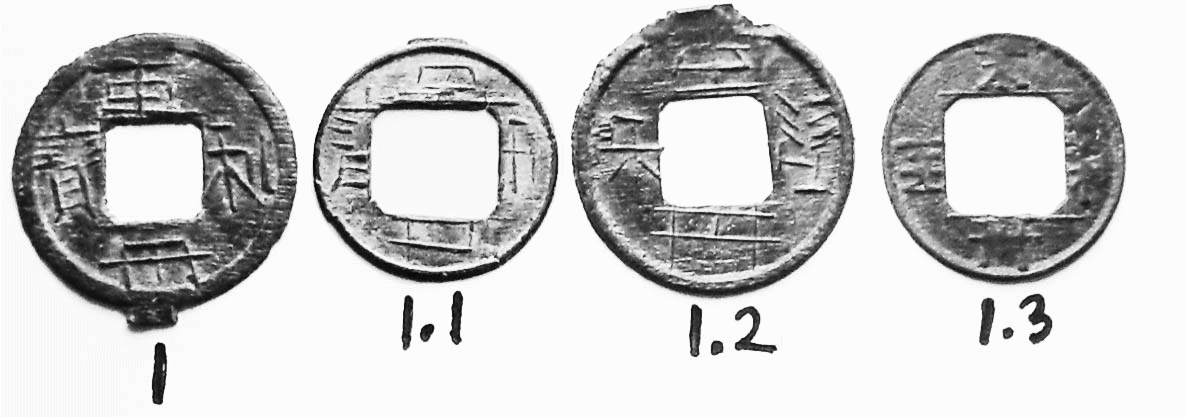
2 Copying
Chinese coin? Xian-Yuan? 16 mm, Netscher 216? R9 (Lead-tin
Indonesian imitations of Chinese coins, particularly Northern Song,
are fairly common. However, the style of this piece is unusual and
distinctive, with several pieces appearing in the hoards.)
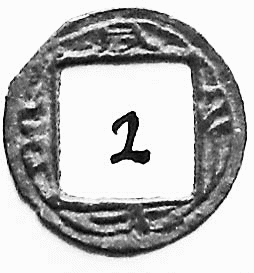
3
Mahmud Baharuddin I,
dated AH 1162 = 1749, "Sultan [or falus] fi bilad Palembang dar
[al] Islam 1162," Millies 184, 22 mm, R5 but almost always found
very poor. Note, the date is at the top.
3.1
21 mm, R10 3.2 20
mm, large center hole, R8
3.3
22 mm, a strange barbarous version of this type? R10
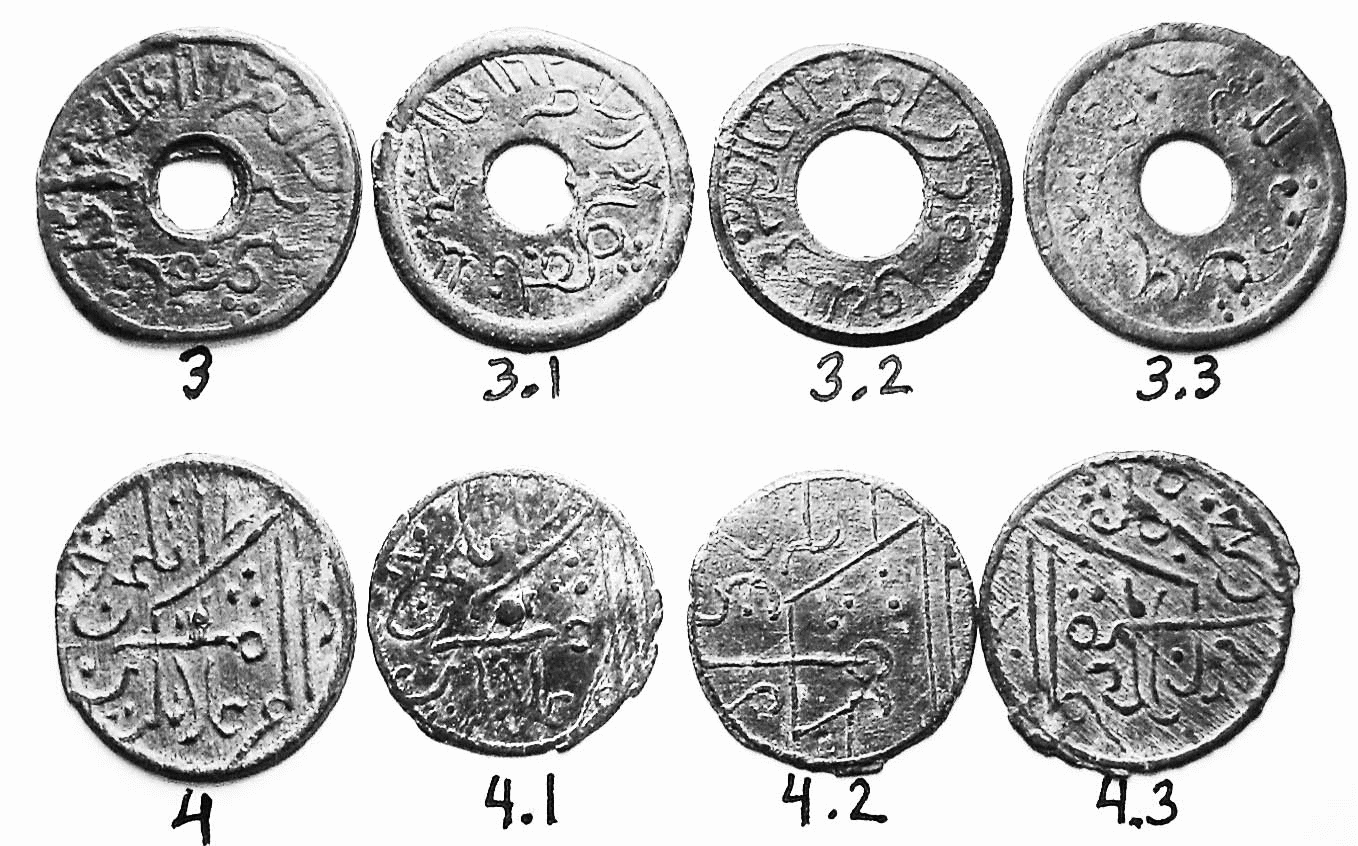
4
Undated (though some sources say AH 1163 = 1750), "Alamat bilad
Palembang," Millies 200, 21 mm, R1
4.1 Smaller
and a little barbarous, 19-20 mm, R7
4.2
A distinctive barbarous version, 20 mm, R8
4.3
As #4 but retrograde (mirror-image), 21 mm, R4
4.4 As
#4.2 but retrograde, 20 mm, R10
5 Muhammad
Bahudin (1776-1804),
AH 1193 = 1779, "Al-Sultan
fi beled Palembang sanat 1193," Millies 187, R1.
All
varieties of this type, below, are 13-15 mm unless noted. Various
different dates have been reported, e.g., 1183 in Millies. However,
all seem to be the same issue; while many do appear as "1183,"
the 8 is really just an ill-written 9 with an overgrown top, as
evidenced by many "in-between" ones seen. Also, because of
its small size, barbarous versions of this type proliferate.
5.1
Large date with clear well-formed 9, R6
5.2
Distinctive rough/crude fabric, always with central casting "button,"
R1
5.3 Distinctive
style with thin characters touching top rim, R5
5.4
Small o before date, R3 5.5
Small size, 13 mm, R1
Date variants:
5.6
1111-, R2 5.7
1183, R2 5.8
193, R4
5.9 113,
R2 5.10 13,
R6 5.11
93, R8
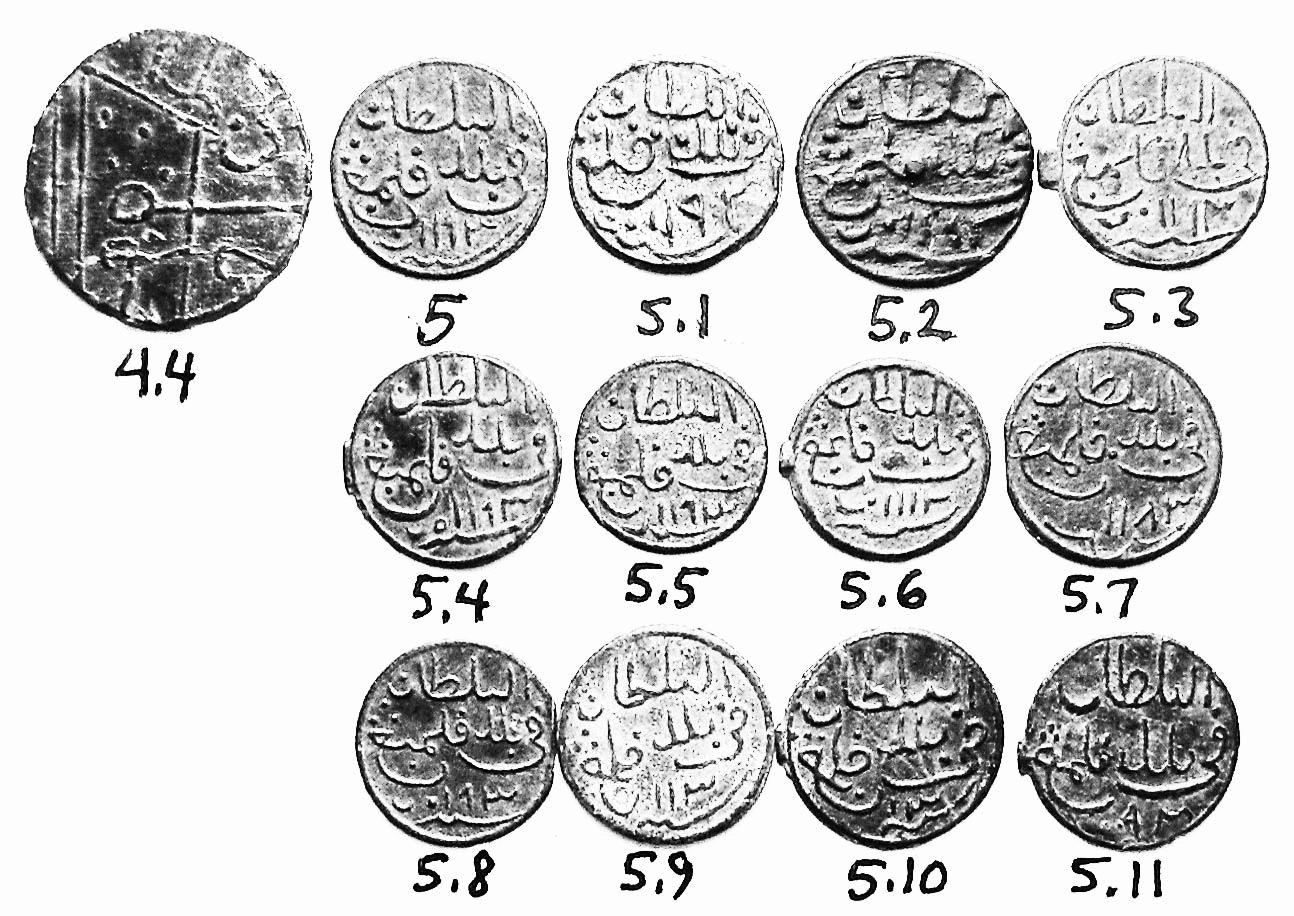
5.12
1183 retrograde, 13 mm,
R10
5.13 1193
retrograde, R10 5.14
1123 (9 reversed), R10
5.15 "3P11,"
R9 5.16
11113, R8 5.17
6111, R7
5.18 "66U,"
R10 5.19
"1J11," R8 5.20 "1J3,"
R9
5.21 113
retrograde, R10 5.22
Date area blank, R8
Additional varieties, consult photos:
5.23,24
R3 5.25 R7
5.26,27 R9 5.28
12 mm, R7
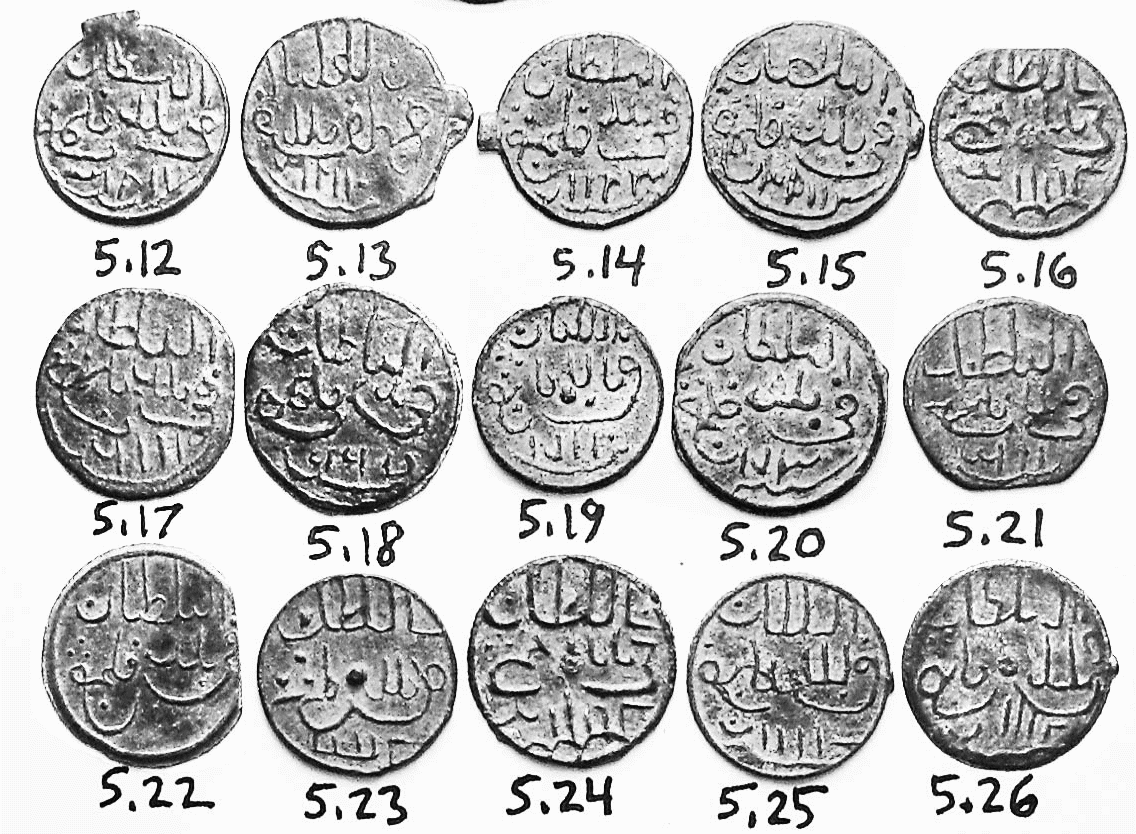
5.29
R6 5.30 R9
5.31 R5
5.32 note top legend, R10
5.33
R9 5.34-36 R10
5.37,38 R6 5.39
R9
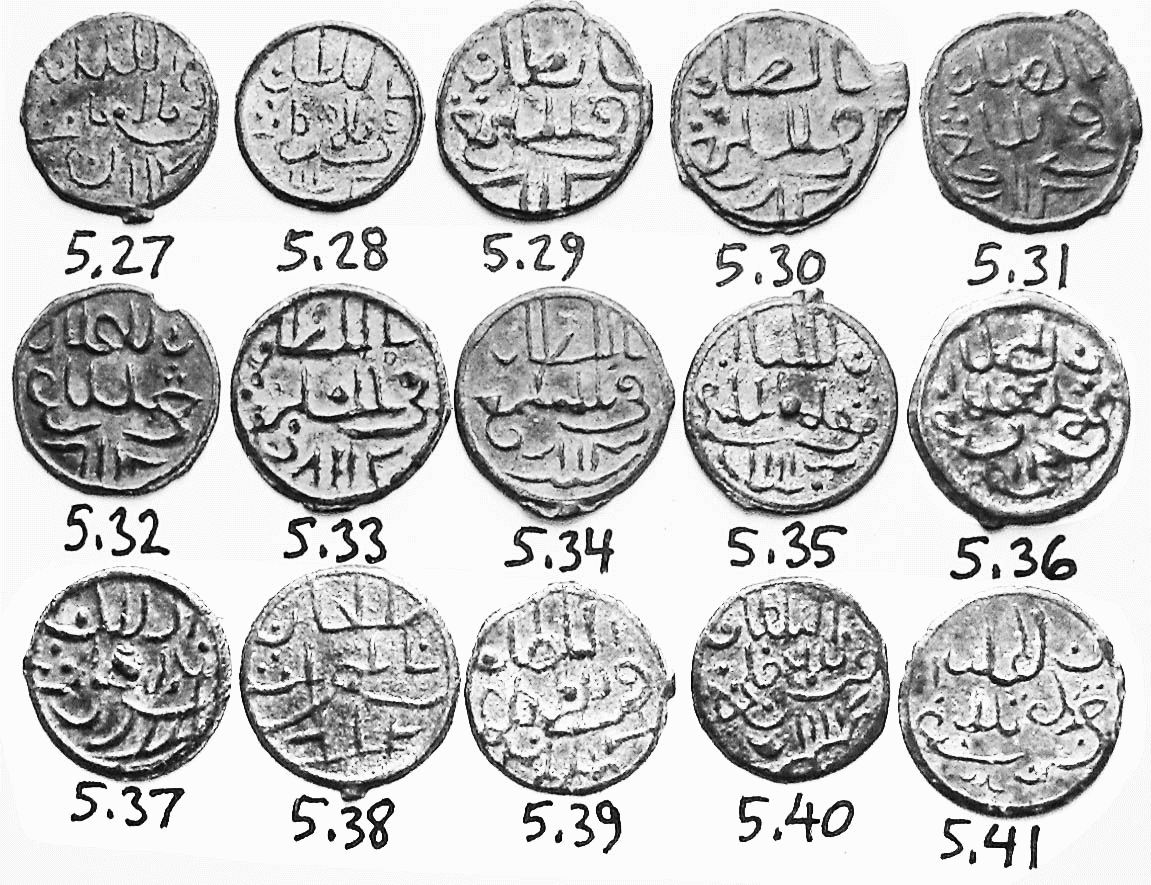
5.40-43 R10
5.44 R8 5.45
R7 5.46 R9
5.47,48 R10
5.49
R9 5.50 R8
5.51,52 R10
5.54 R8 5.55-58
R10
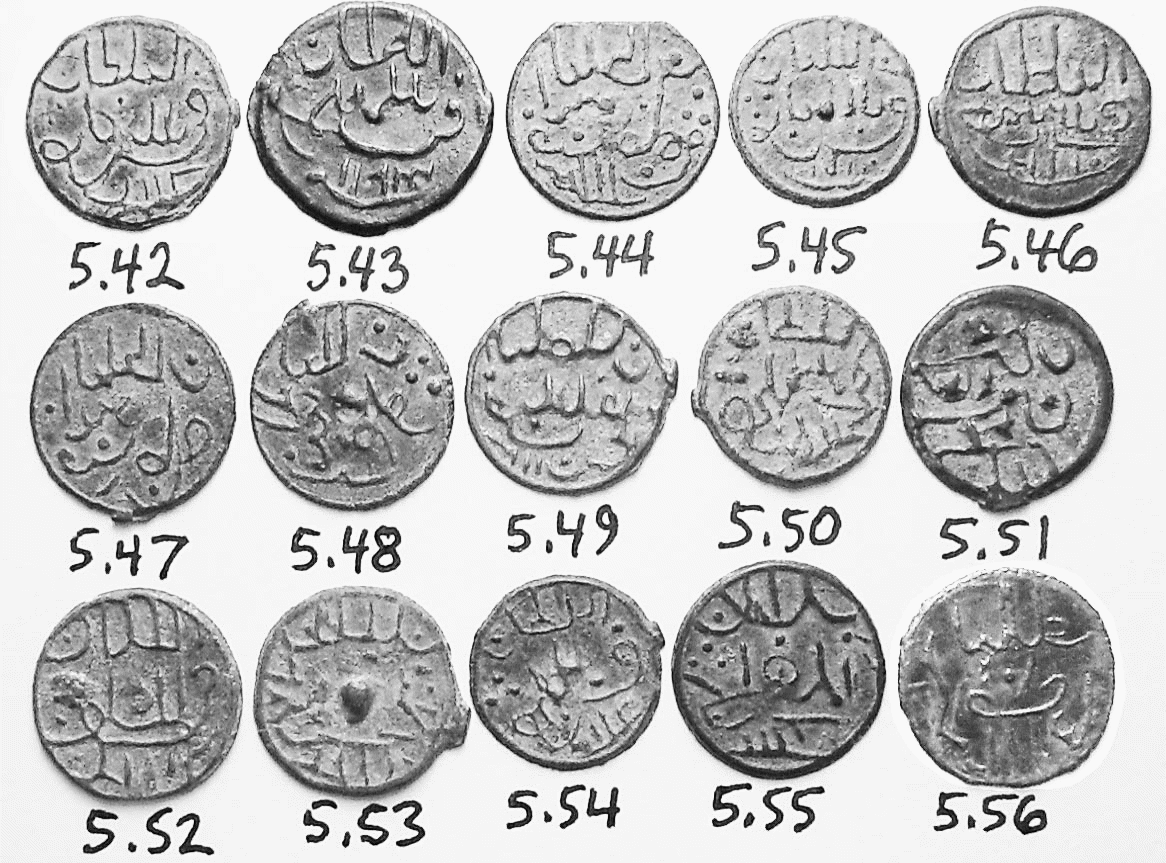
5.59 Small
central hole appears as made, R10
5.60
R10 5.61 Many
variants generally
similar, R8
5.62
R10
5.63 R8
6
AH1198=1784, COPPER
coin, 21 mm, "Haza fulus fi bilad Palembang sanat" ("piece
of copper of the city of Palembang, Year 1198"), Millies 188,
Craig 112 ("Duit"), R10. (Note, none found in the river
hoards.)
7
AH1200=1786, "Al-sultan fi beled Palembang sanat 1200,"
date retrograde (backwards), 18 mm, Millies 189, R2 but always in
shallow relief hence nice ones are much rarer. Noting the many
corrupted dates on the 1193 and 1203 issues, one might suppose this
is just one more variant of the latter. However, its commonness and
close uniformity of distinctive style suggest this was a separate
issue.
Note, the coin pictured as 7.1 has been deleted. The
coin labelled "7.2" is actually now 7.1; the one labelled
"7.3" is 7.2
7.1
Barbarous style, large calligraphy, 18 mm, R10
7.2
Date
as 12100, R10
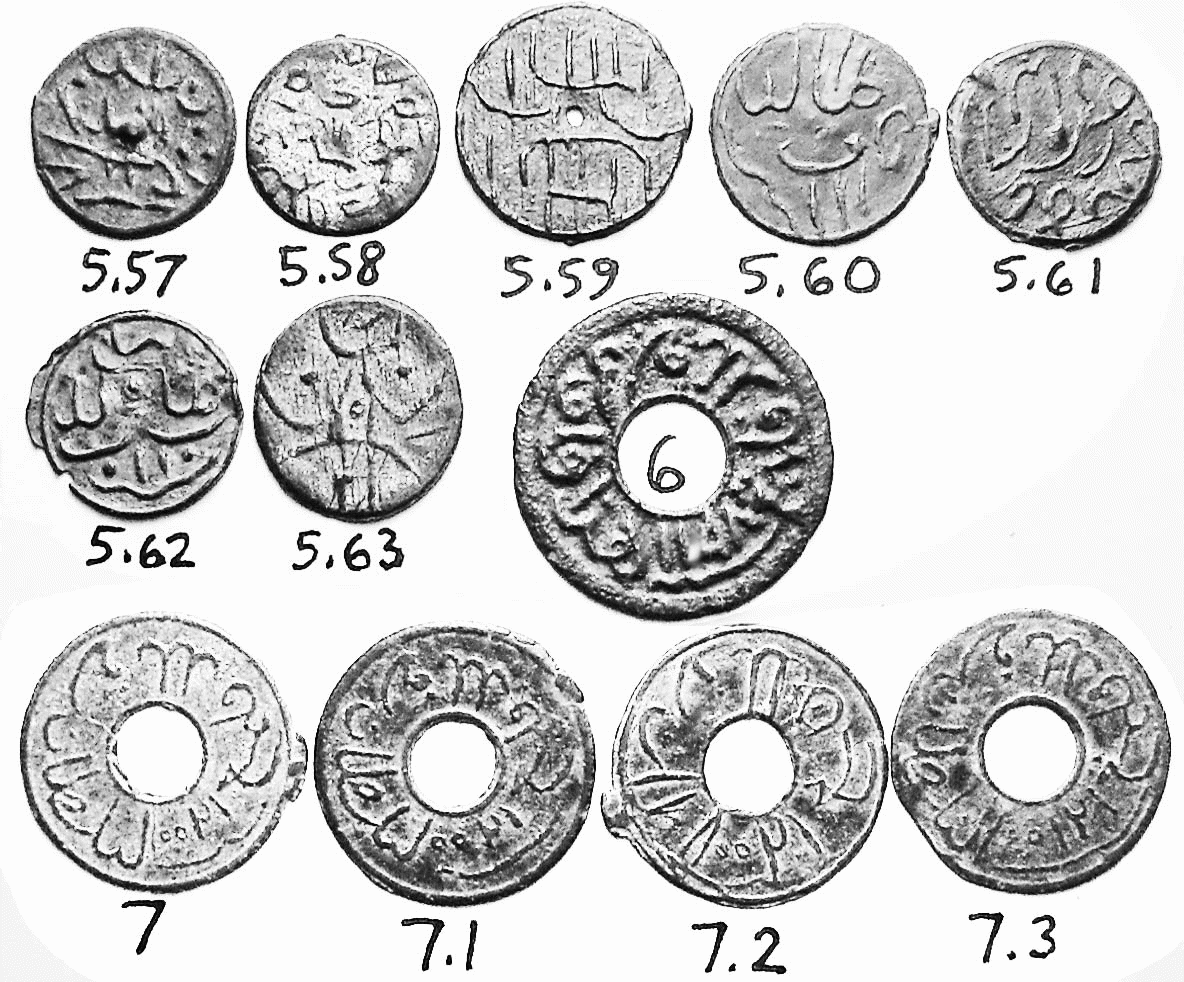
8
AH1202=1788, 18-19 mm, "Al-sultan fi beled Palembang sanat
1202," Millies 191, R4. Again one might think these mere
variants of the 1203s. Some probably are, but some seem to be a
distinct issue intentionally dated 1202
8.1,2
18 mm, R10 8.3
Date "202," 19 mm, R8
8.4
Date "202," different style, 19 mm, R9
8.5
Date small and weak, 17 mm, R9 8.6
17-18 mm, R9
8.7
Date with large round O, 19 mm, R5
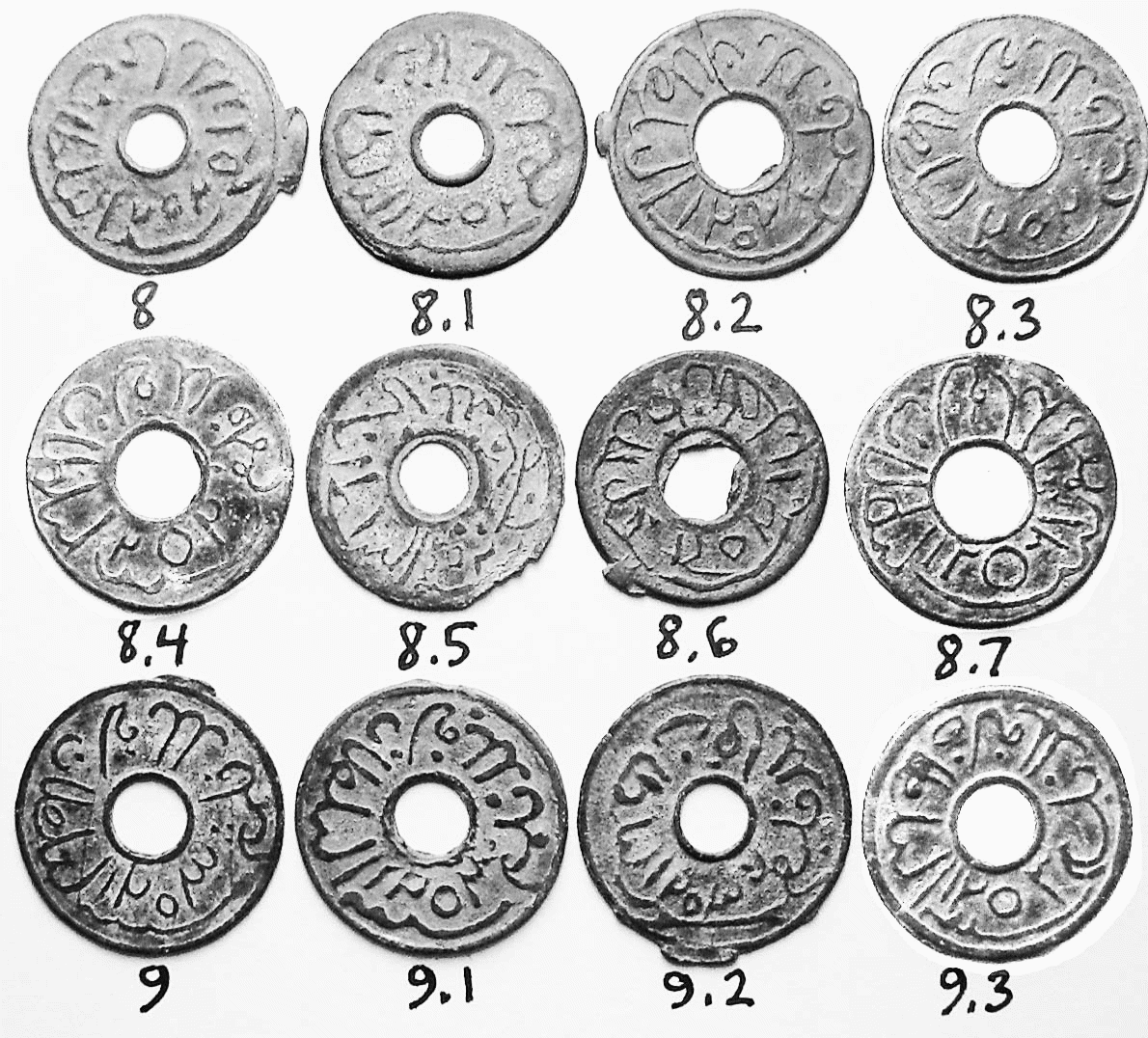
9
AH1203=1789, "Al-sultan fi beled Palembang sanat 1203,"
18-19 mm, Millies 192, R1. Stylistic variations:
9.1
R1 9.2
R2 9.3
R10
9.4
small date, R9
9.5
Usual character at top omitted, R9 9.6
R9
9.7 R10
9.8
R3
9.9 2
in date backwards, always very shallow relief, R3
Retrograde
(mirror-image) varieties:
9.10
R5
9.11
R7 9.12
R8 9.13
R10
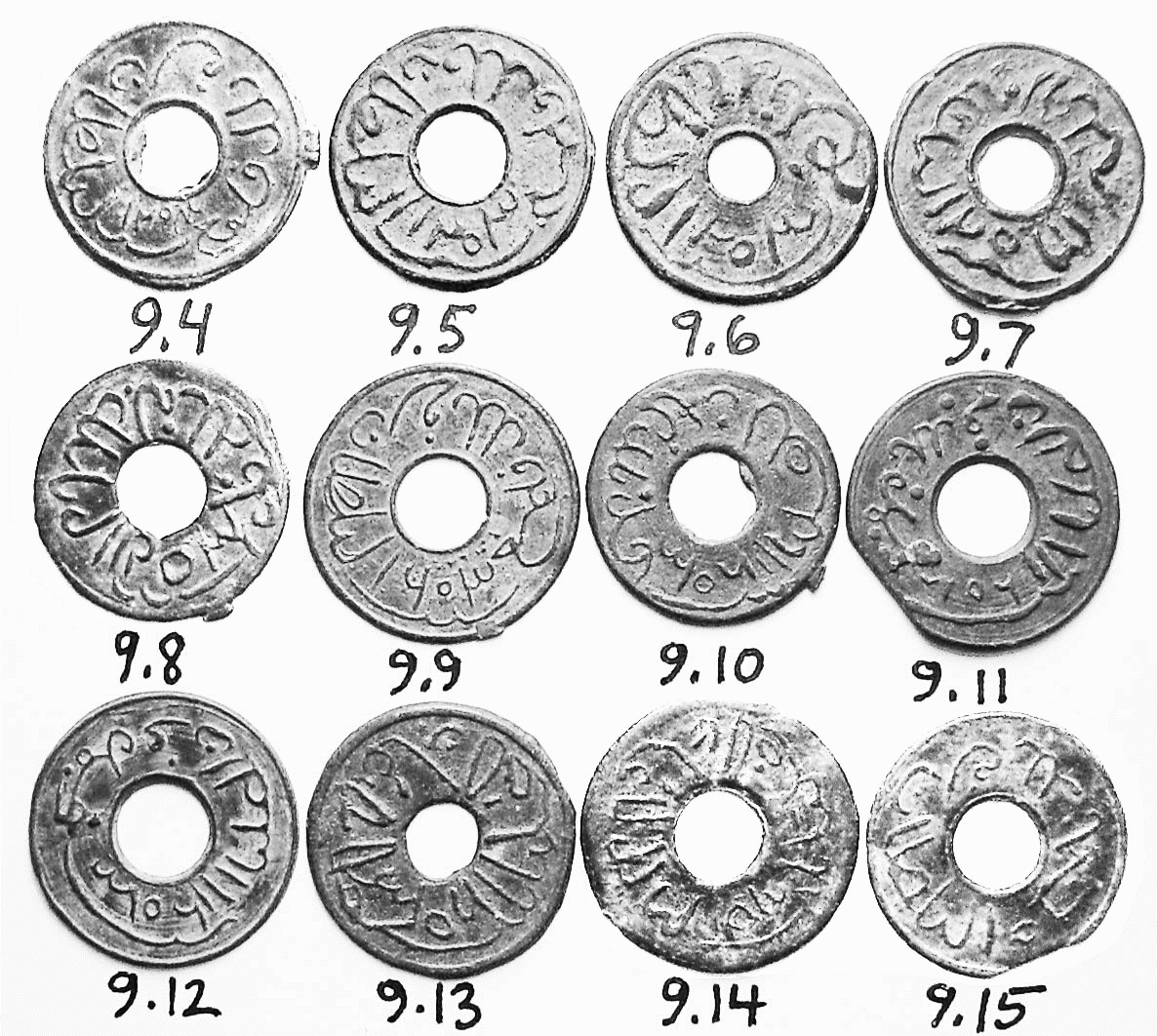
Error dates, in more or less numerical order:
9.14
03, R10 9.15
10, R7 9.16
12,
R8 9.17
21, R8
9.18
23, R10 9.19
63, R10 9.20
093,
R10
9.21
101 (probably actually 202 with 2s ill-formed), R7
9.22
103, R10 9.23
111, R10 9.24
112, R10 9.25
120, R9
9.26
123,
R3 9.27
203, R9 9.28
203, different style, R9
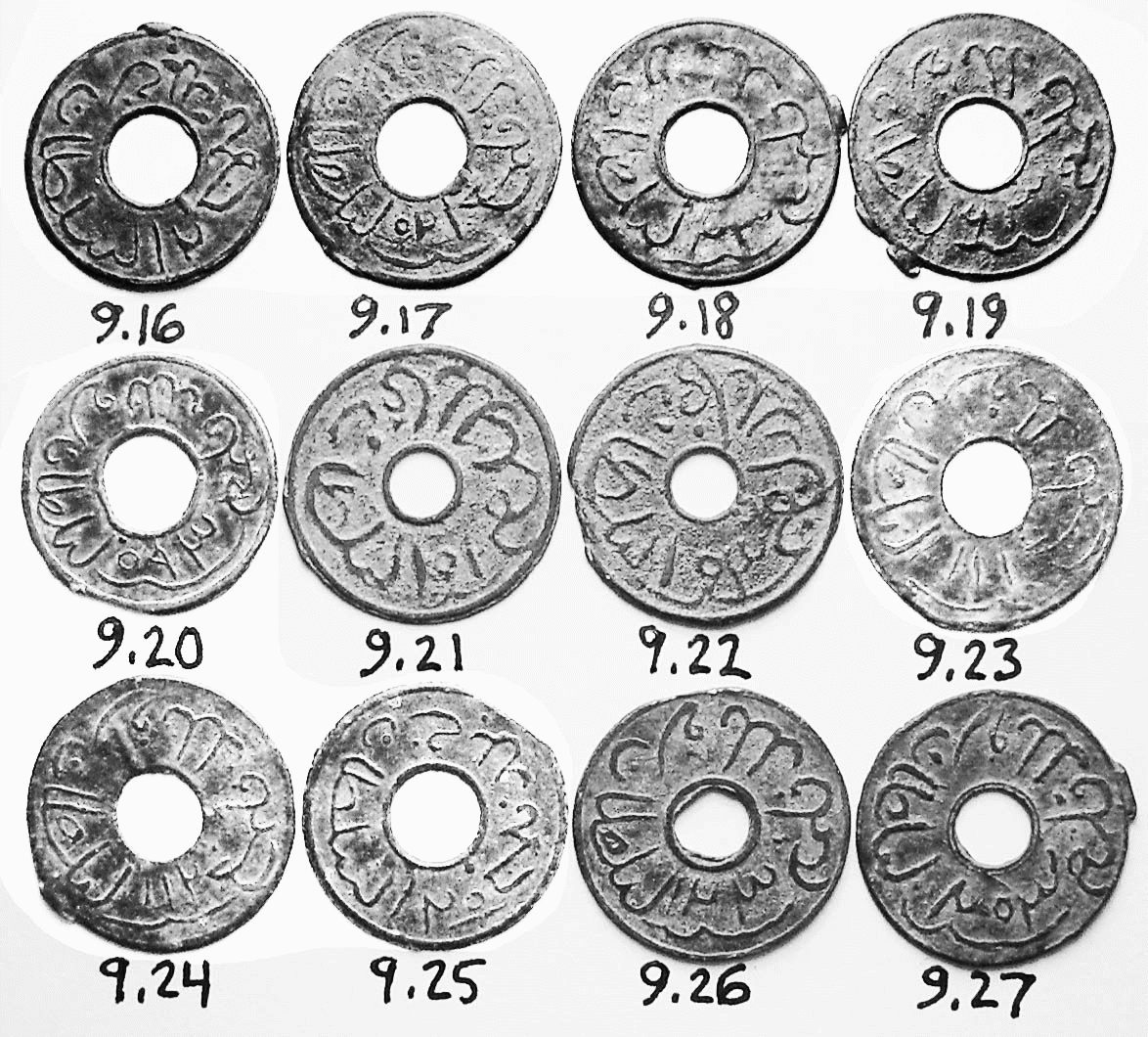
9.29
302, R9 9.30
302,
different style, small date, R10
9.31
306? entirely retrograde (mirror-image), very crude, R4
9.32
604? R10 9.33
1023,
R2 9.34
1063, R9 9.35
1102, R10
9.36
2013,
R9 9.37
2203, R8
9.38
10083, R10
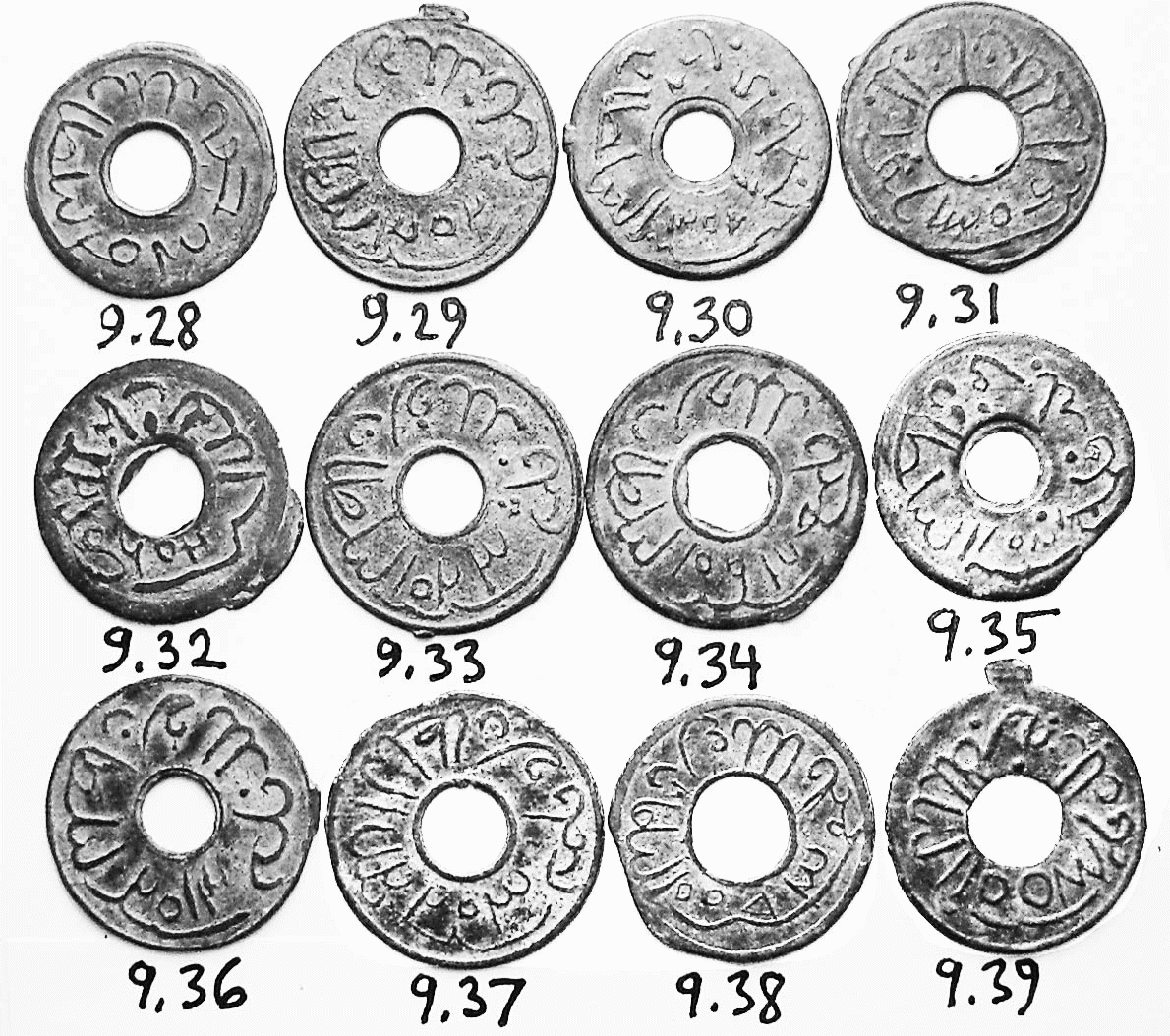
9.39
11003, R9 9.40
11103, R7 9.41
"P9P3" R10
9.42
Strange date, R9 9.43
Date area clearly blank, R10
Further varieties, see
photos:
9.44
R8 9.45
R9 9.46
R10 9.47
R8
9.48
R4 9.49
R9 9.50
R9
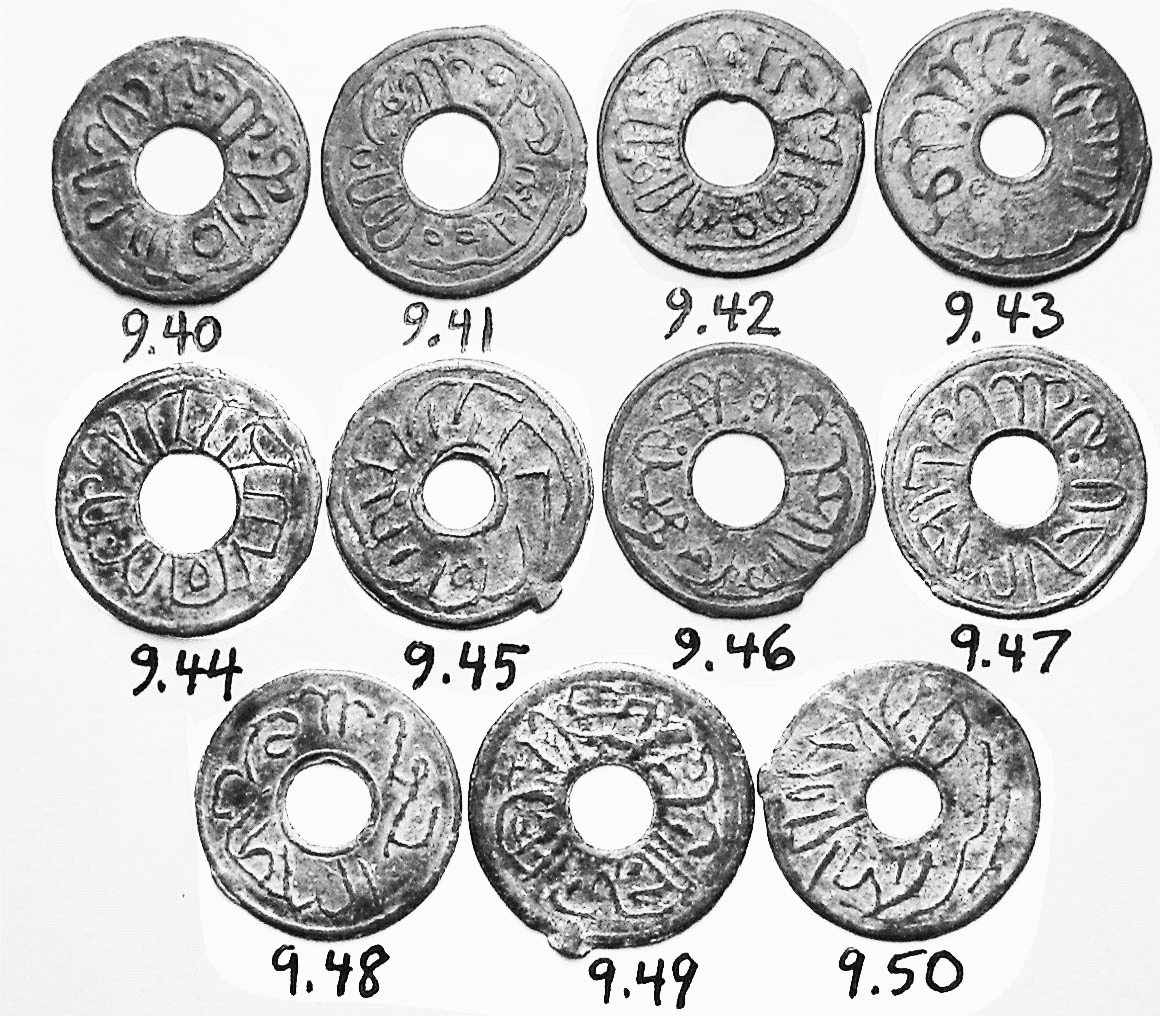
10
Mahmud
Badaruddin II
(1804-21), AH1219=1804, "Masruf fi bilad Palembang 1219,"
Octagonal with round central hole, Millies 195-97, 17-18 mm, R1
Stylistic varieties:
10.1
R5 10.2
R6 10.3
R4 10.4
R6 10.5
R9
10.6
& 10.7
R8 10.8-12
& 12A
all R10
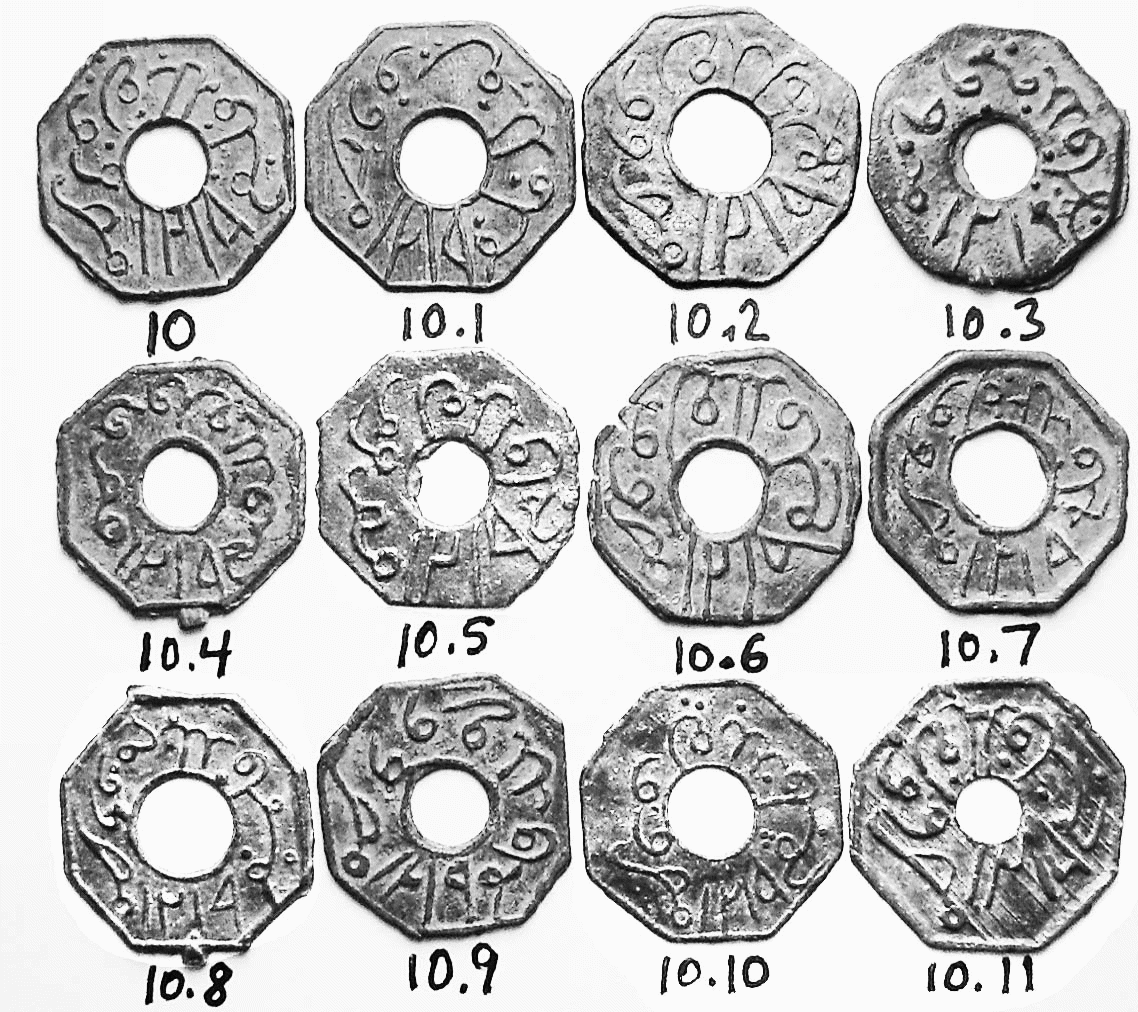
Retrograde (mirror-image) varieties:
10.13
R4 10.14
R8 10.15
R10
10.16 2
reversed, R10
10.17
relatively crude, R2
Bungled dates, in numerical order:
10.18
2, R10 10.19
11, R9 10.20
19, R10
10.21
121, very crude issue, most very weak, R6
10.22
121 retrograde, R10 10.23
129 retrograde, R8
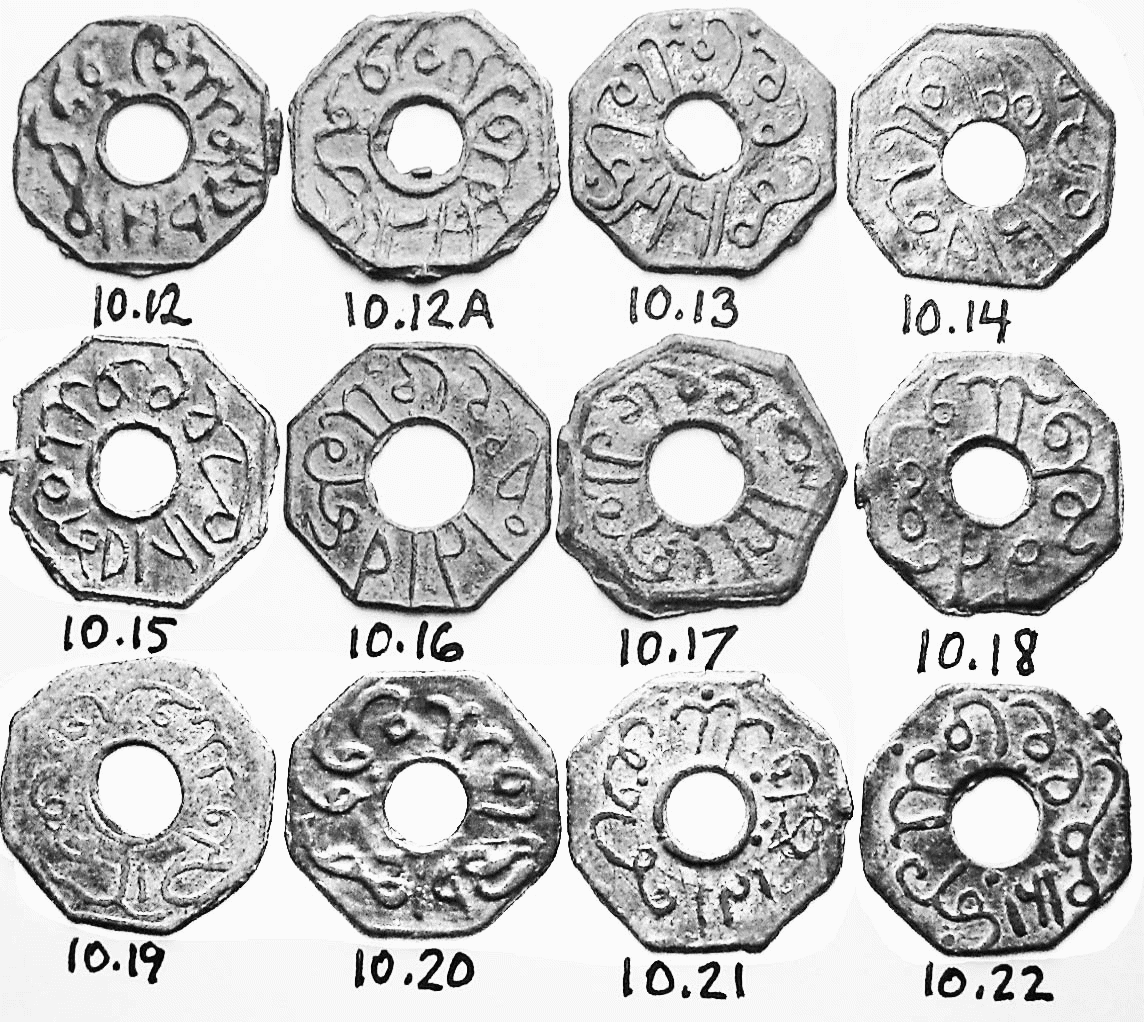
10.24
219, R9 10.25
219,
9 backwards, R9
10.26
219 retrograde, R10
10.27
1011, R10 10.28
1091, R9
10.29
1111, R7 10.30
1211, R9 10.31
1216, R10
10.32
1218, R9 10.33
1291, R9
10.34
1619, R8
10.35
1911 retrograde, R10 10.36
2191, R10 10.37
11219, R10
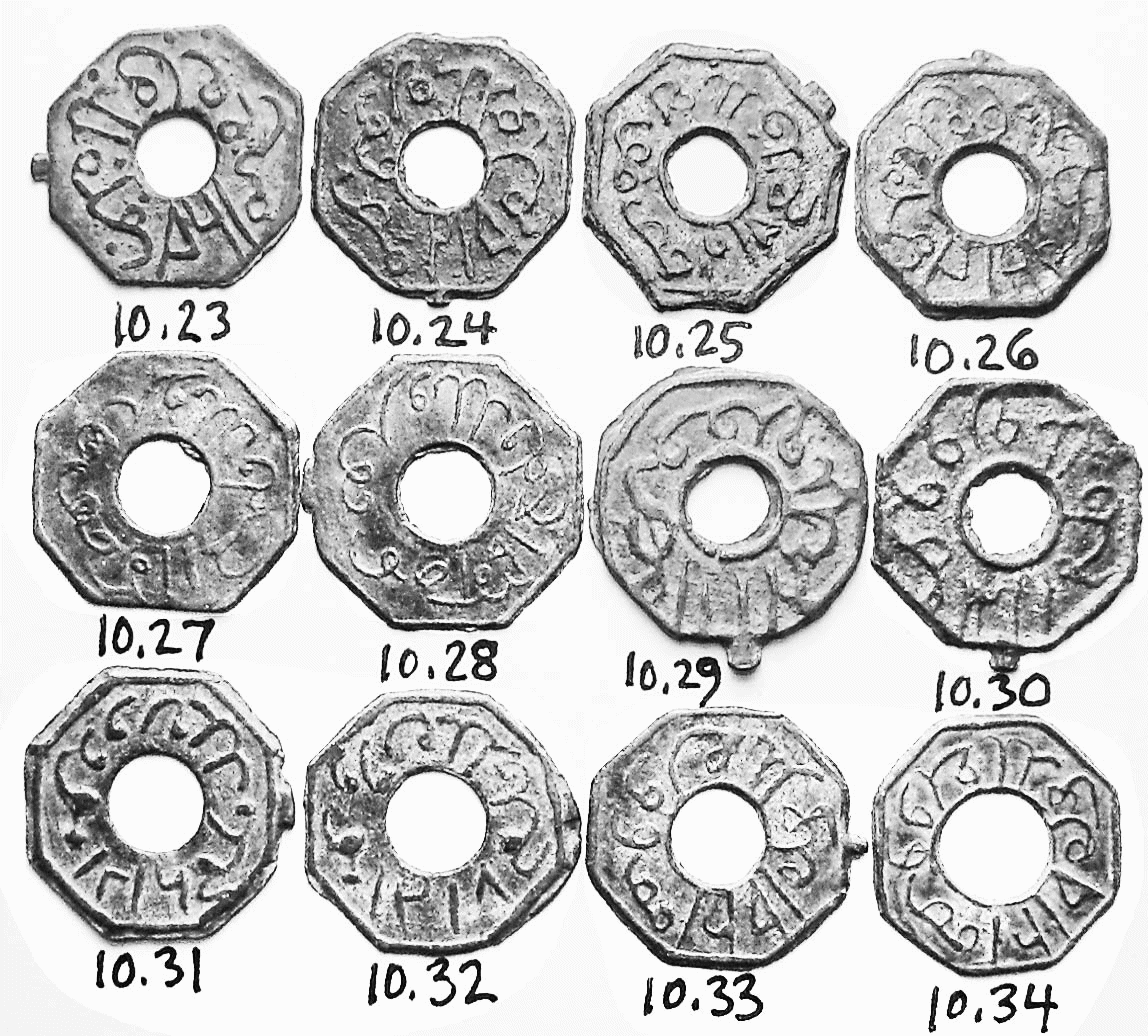
Additional barbarous varieties:
10.38,39
R10 10.40
R7 10.41
R9
Smaller size:
10.42
15-16 mm, Millies 198, R5
10.43
15-16 mm, R10
10.44
14 mm, R3 10.45
14 mm, R10
10.46
13 mm, Millies 199, R1 10.47
13 mm, date 221, R9 10.48
12 mm, date 12, R10 10.49
10 mm, R8
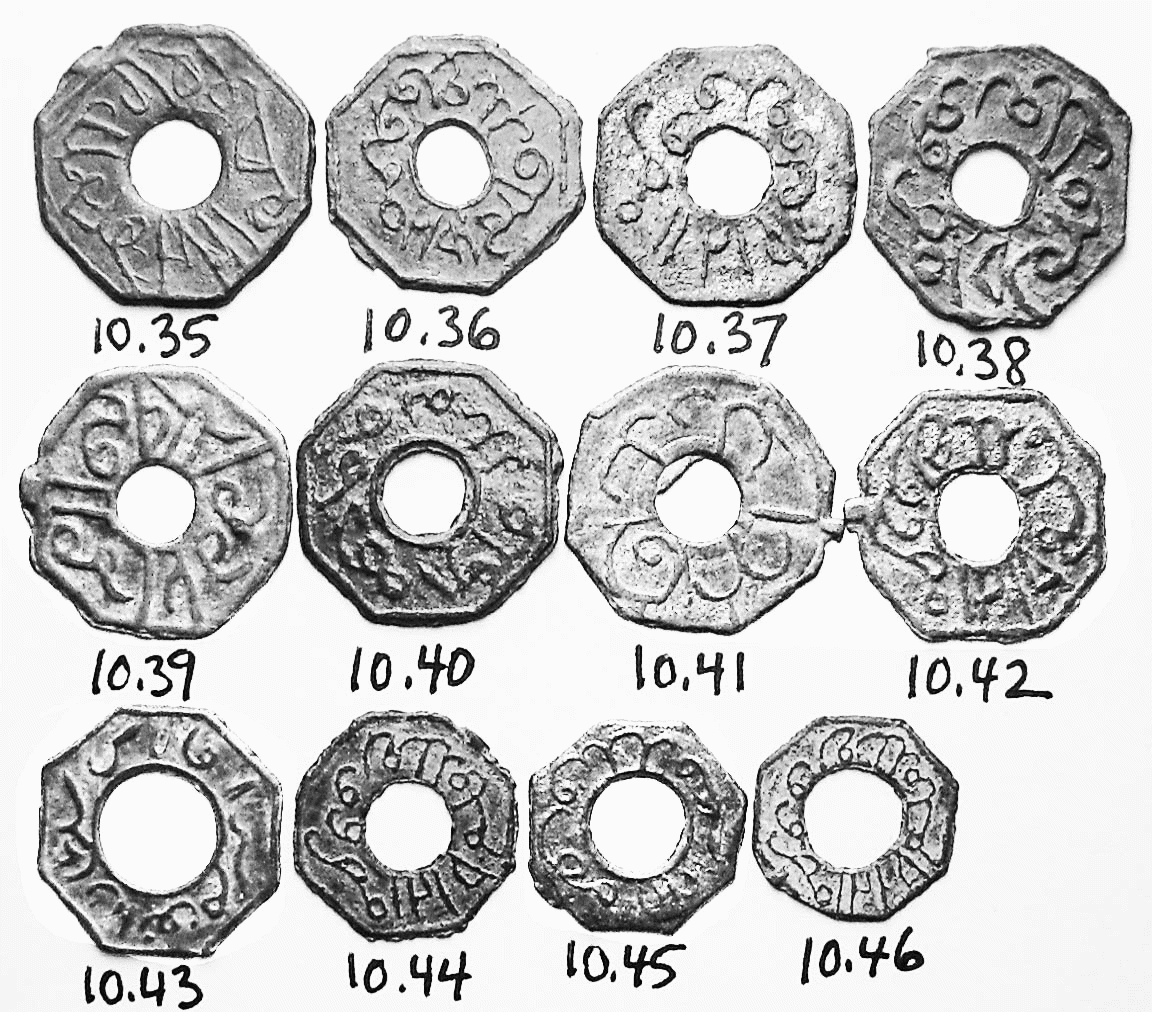
11
Undated, "Zarb fi bilad Palembang dar al-Islam," Millies
202-203, 19-20 mm, R1 (Hint: for identification of varieties, focus
first on the part of the inscription at bottom.)
11.1
R1 11.2
18 mm, R6 11.3
R3 11.4 R5
11.5
R7
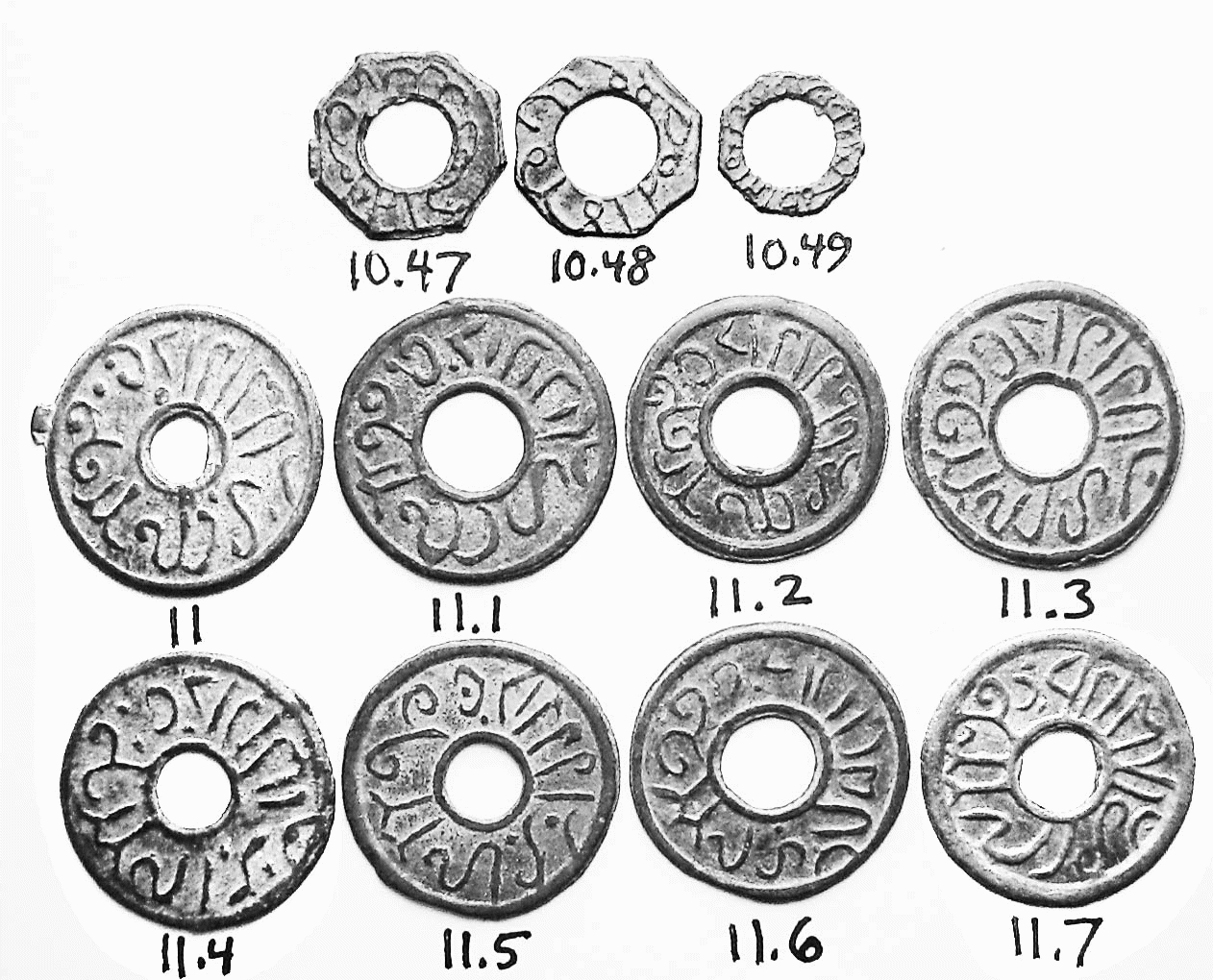
11.6
R7 11.7
R7
11.8
R8 11.9
R10 11.10
R9
11.11
R3 11.12
R1 11.13
R8
11.14
R10
Retrograde
(mirror-image):
11.15
R5 11.16
R6 11.17
R7
11.18
R8 11.19
R9 11.20
R10
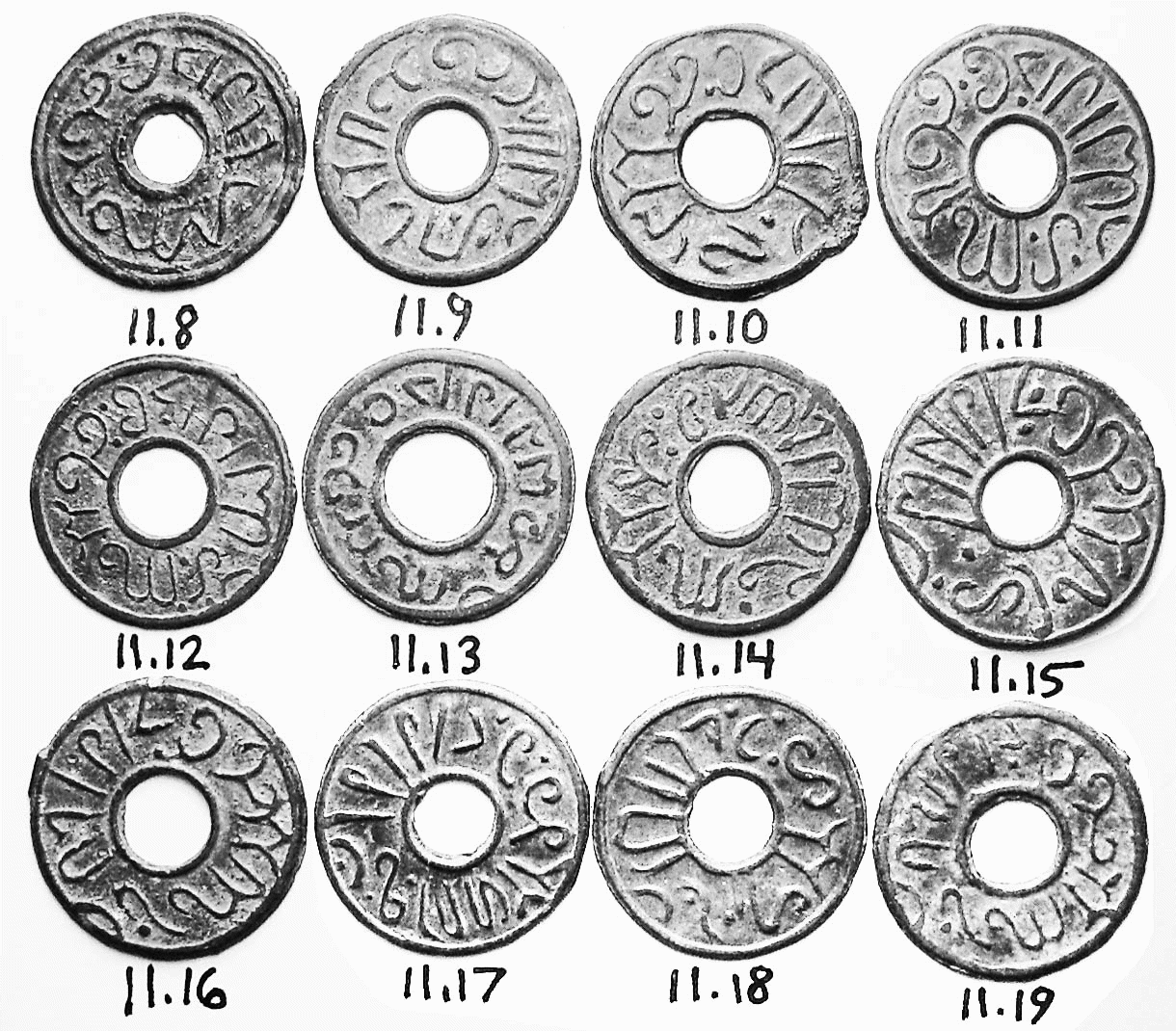
Additional varieties:
11.21
R3 11.22
R4 11.23
R9
11.24
(Note ">" at top instead of "<") R6
11.25
R8
11.26
R10 11.27
R8 11.28
R9 11.29 &
29A
R10
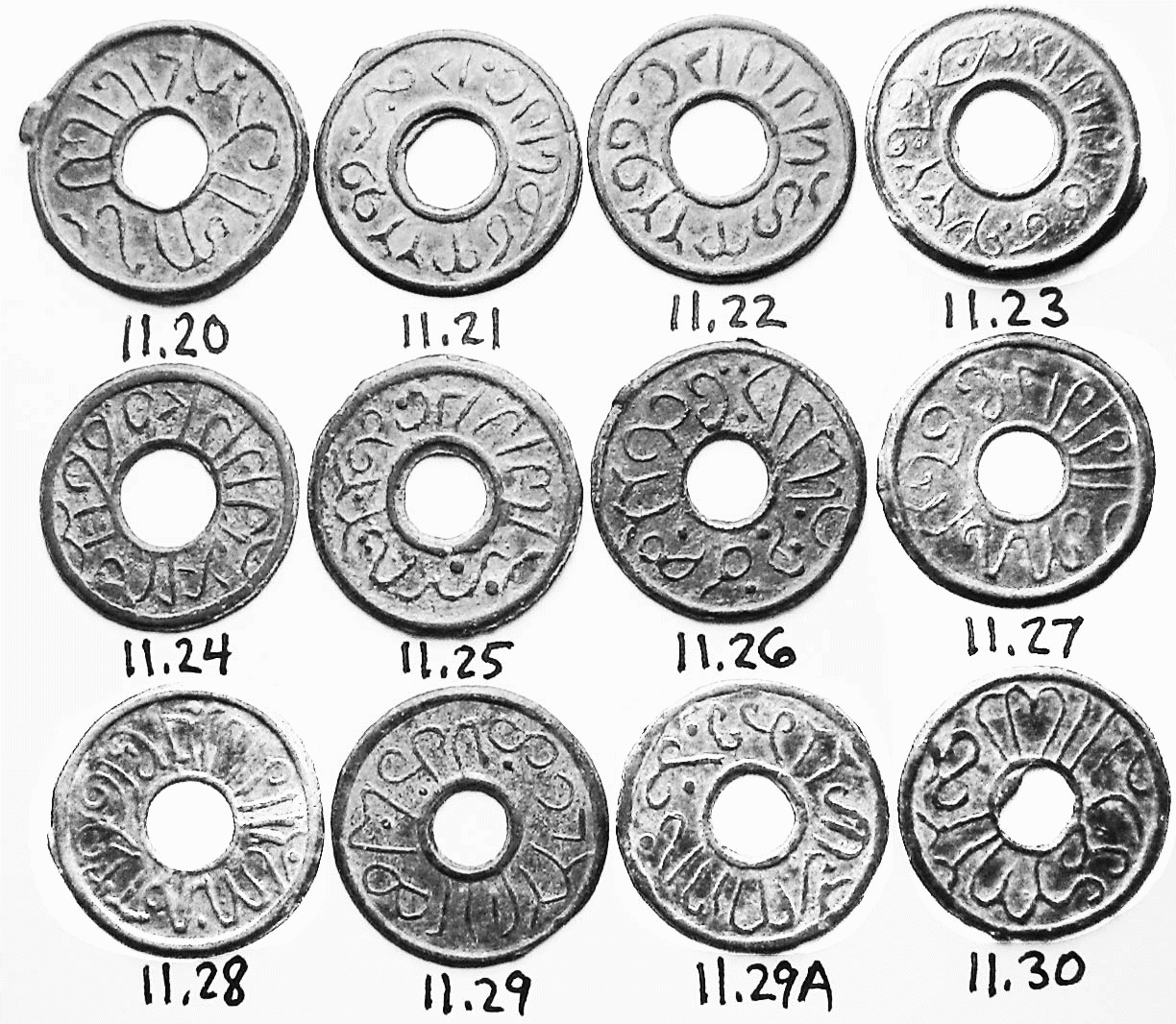
11.30,31
R8 11.31A R10
11.32
R8 11.33
R10
11.34,35
R9 11.36
R7 11.37
R8 11.38-44
R10
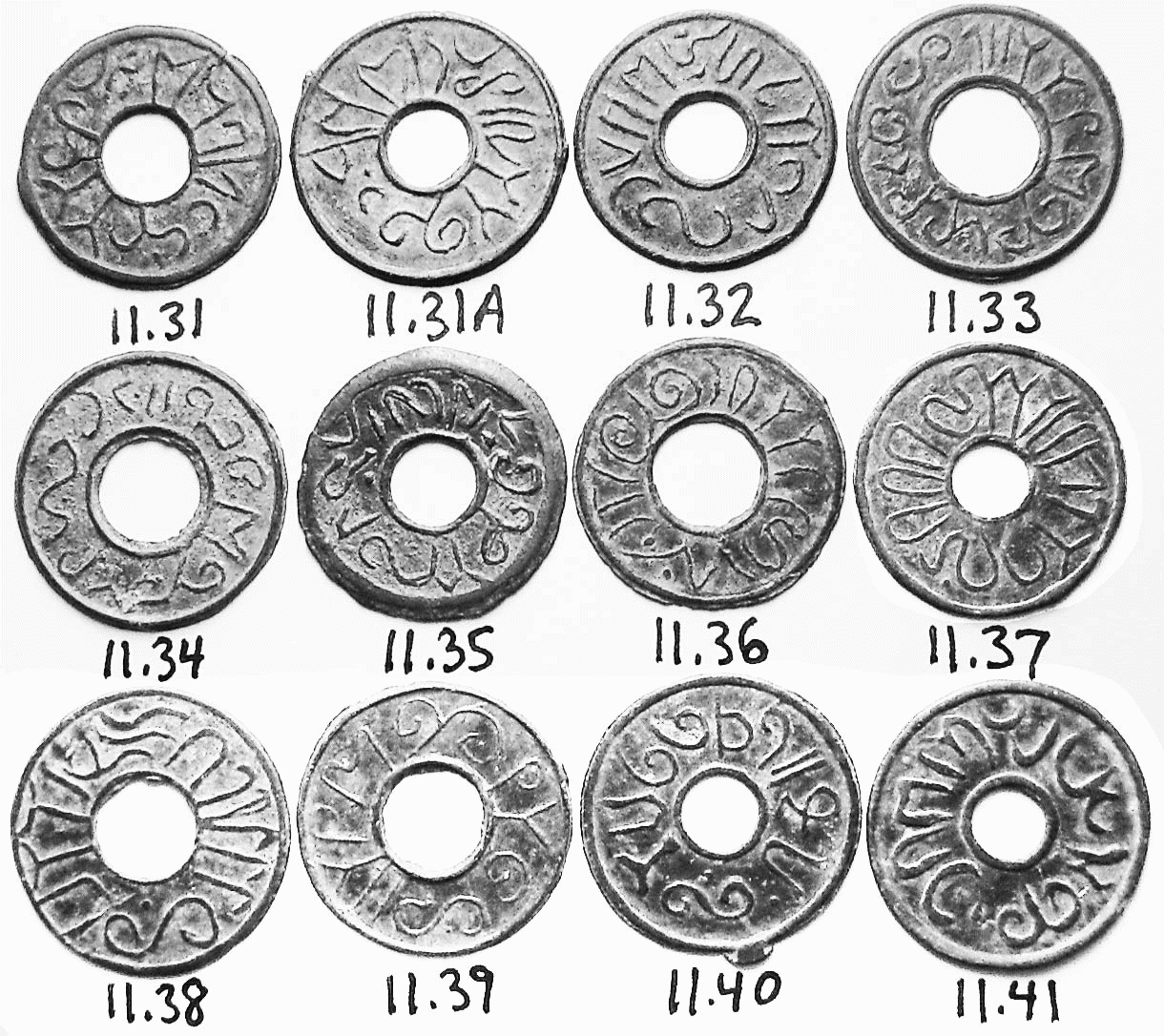
11.45,46
R9 11.47
R10 11.48
R8 11.49
R10
11.50-52
R9 11.53
R10
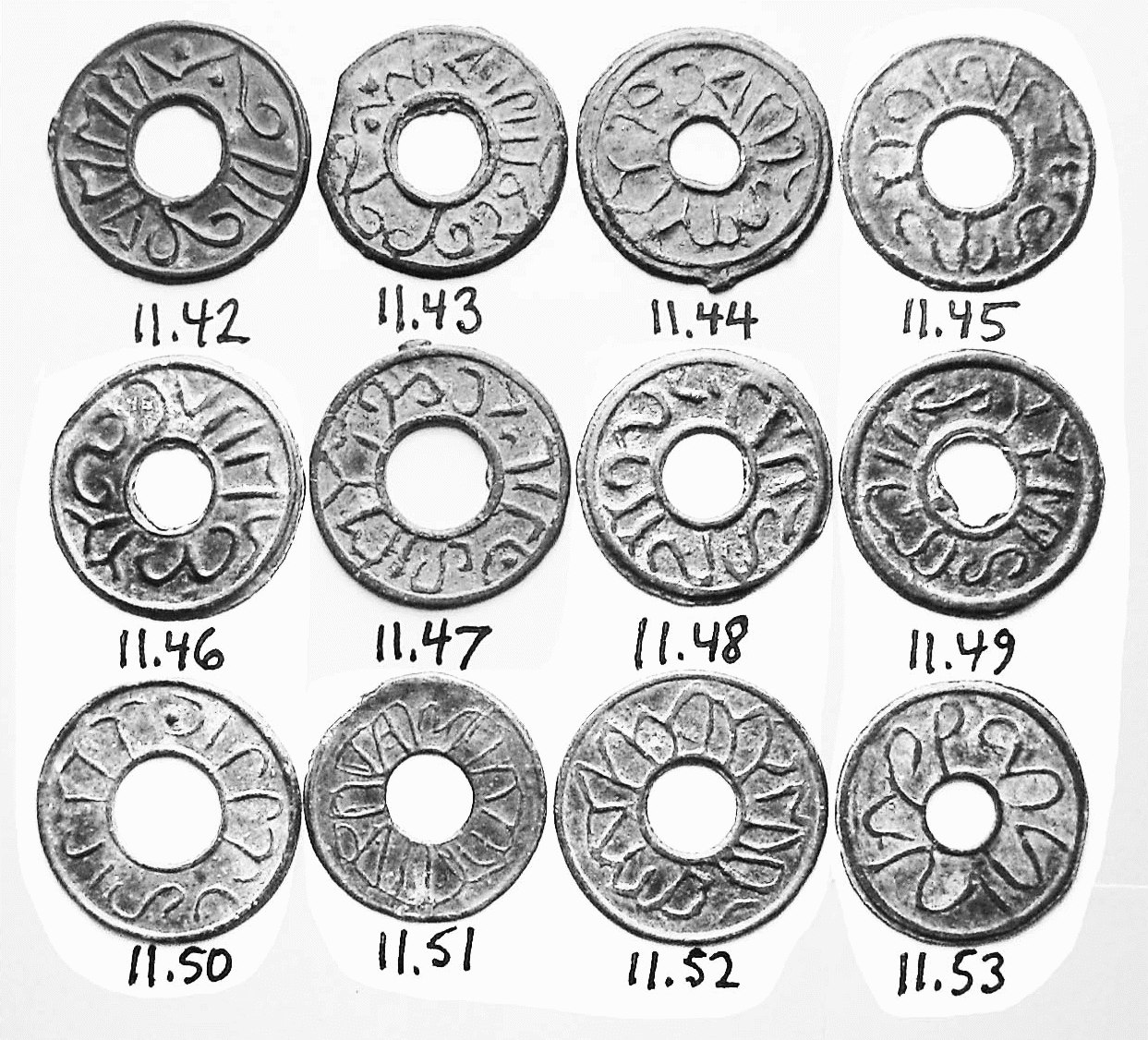
12
Similar
but legend differs, Millies 204, 19 mm, R5
12.1
R7
13 Barbarous variant of Type 11? Very different, 19 mm, R7
14
Another undated type similar to previous, readily disting-uished by
the character like a "2," 19-20 mm, Millies 201, R1
14.1
R6 14.2 R4
14.3
R9 14.4
R5 14.5
R9
Retrograde: 14.6
R10 14.7
R9
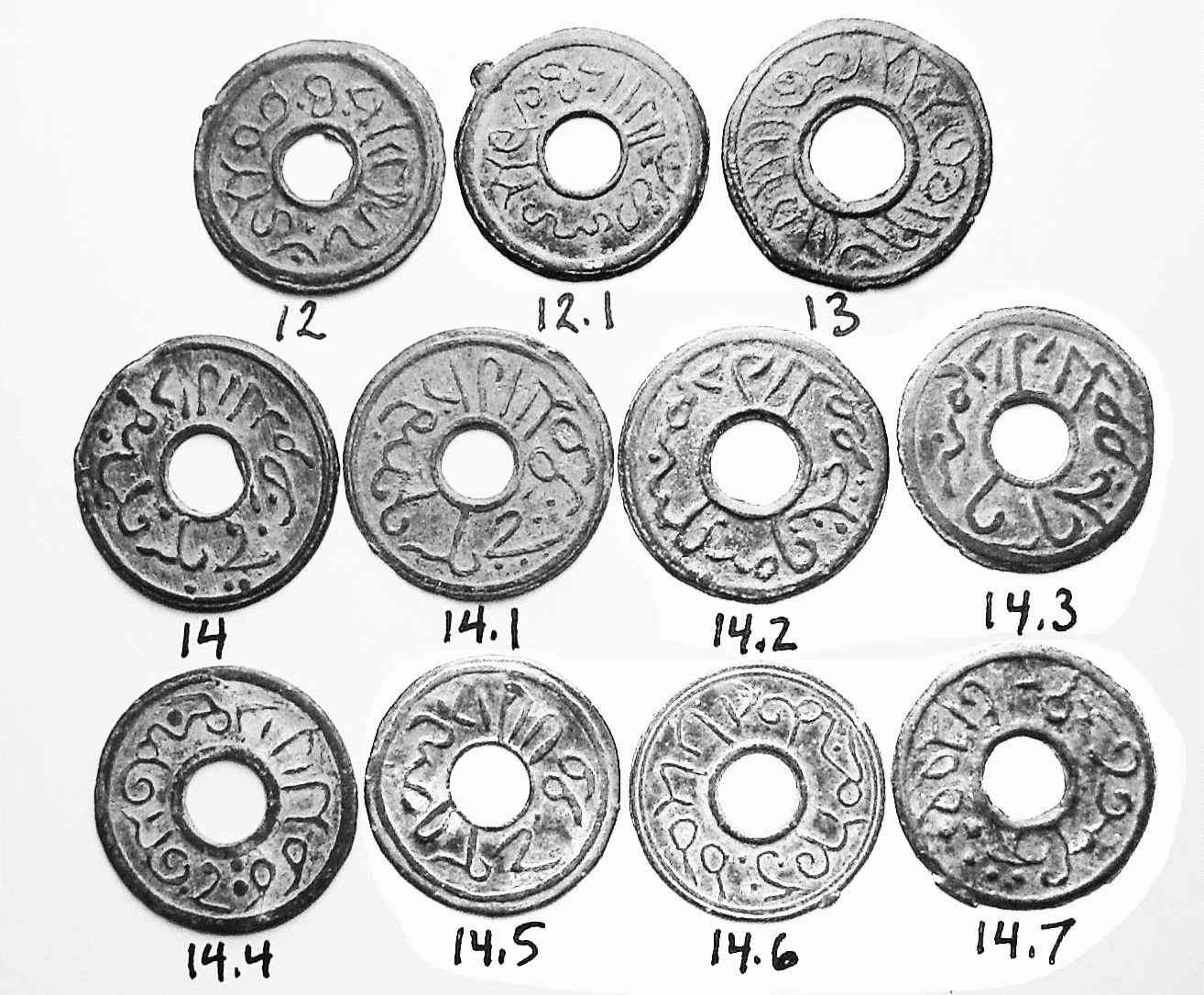
15
Similar
to last but lacking the "2" shaped character; also similar
to Type 12 but with double loop formation at left; 19-20 mm, R5
15.1
R10 15.2
lacks "YY" character, R10
15.3,4
Double
loops on right, R8
16
Small size, 15 mm, R1, but nice ones much scarcer.
16.1
Retrograde, R6 16.2
R5 16.3
R10 16.4
R6
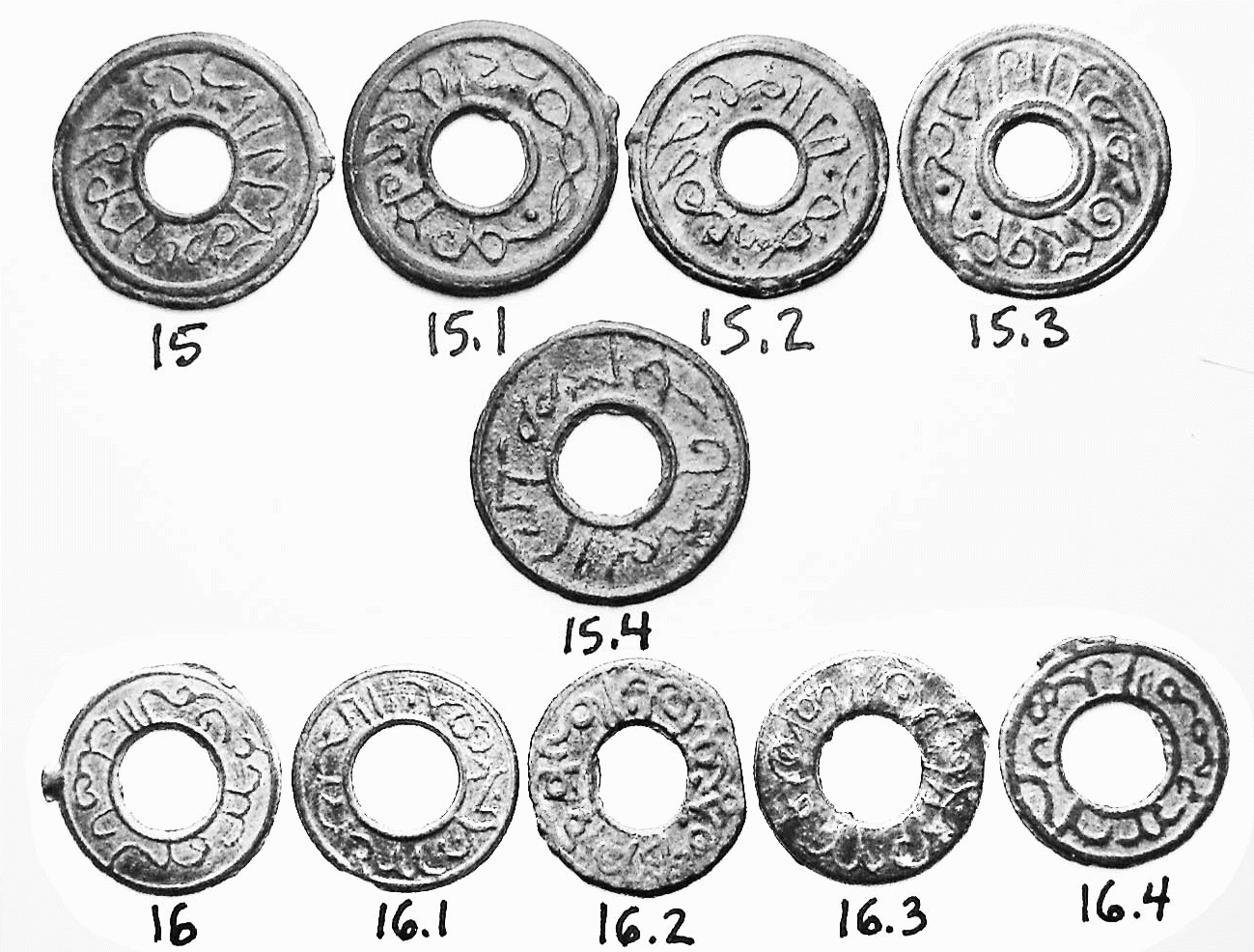
16.5
14 mm, R5 16.6
R8 16.7
R10 16.8
R9
16.9
Many variants with S-like characters at right & left and some
parallel lines at top and/or bottom, R6
16.10
13-14 mm with large central hole, R6
16.11
Extremely crude pseudo-legends; many permutations; enough like this
found to warrant a listing, R6
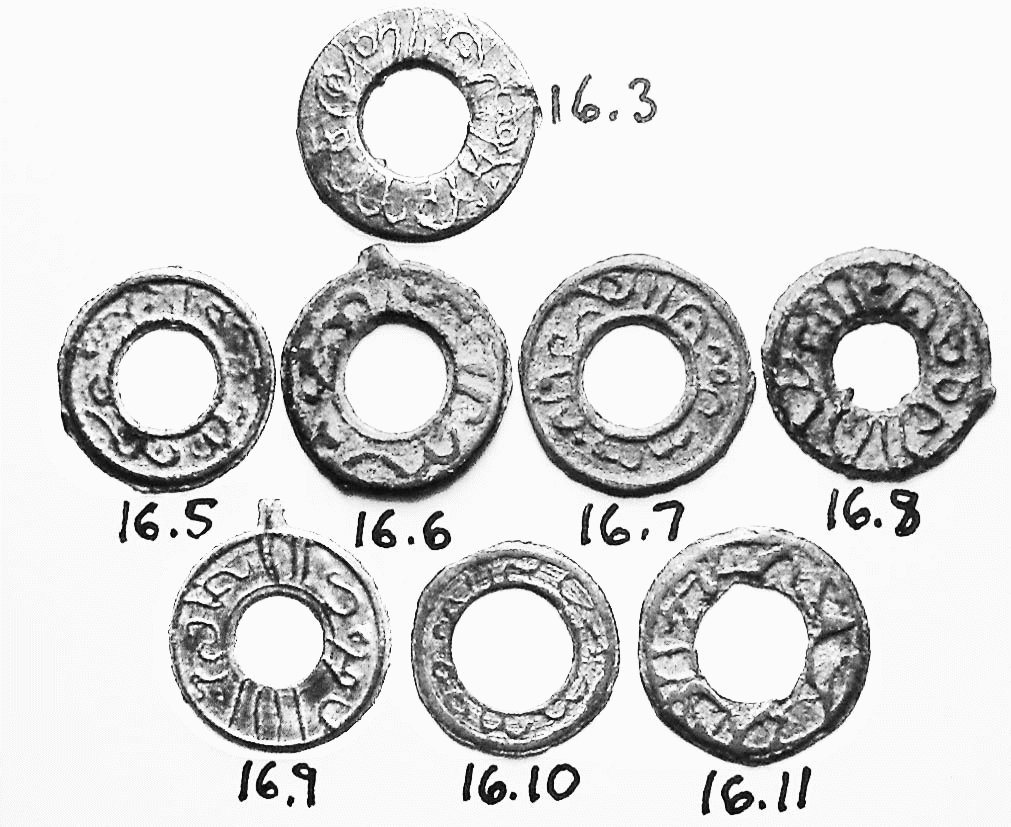
17
Four
characters around square hole, "Alaa min sultan," 18 mm,
Millies 206; often with incomplete flans. Dating uncertain; some
sources say Eighteenth Century. (Note, a F+ was reported sold at $75
by "Anything Anywhere," 7/14) R2
17.1
16-17 mm, Millies 207, R2
17.2
15 mm, large central hole, R6
17.3
Retrograde (mirror image), Millies 208, 17-18 mm, R8
17.4
Characters at sides inverted; bottom character not retrograde, 17 mm,
R7
17.5
Same but right character not inverted, 17 mm, R10
17.6
Characters at right & left face the other way, Millies 209, 16
mm, R10 (only one low grade example found; hence the Millies picture
is being shown here as well)
17.7
Same but only left character faces the other way, R10
17.8
Characters at left & bottom switched, 16 mm, R10
17.9
Left
character repeated at bottom, 16 mm, R10
17.10
Left character omitted, 16 mm, R10
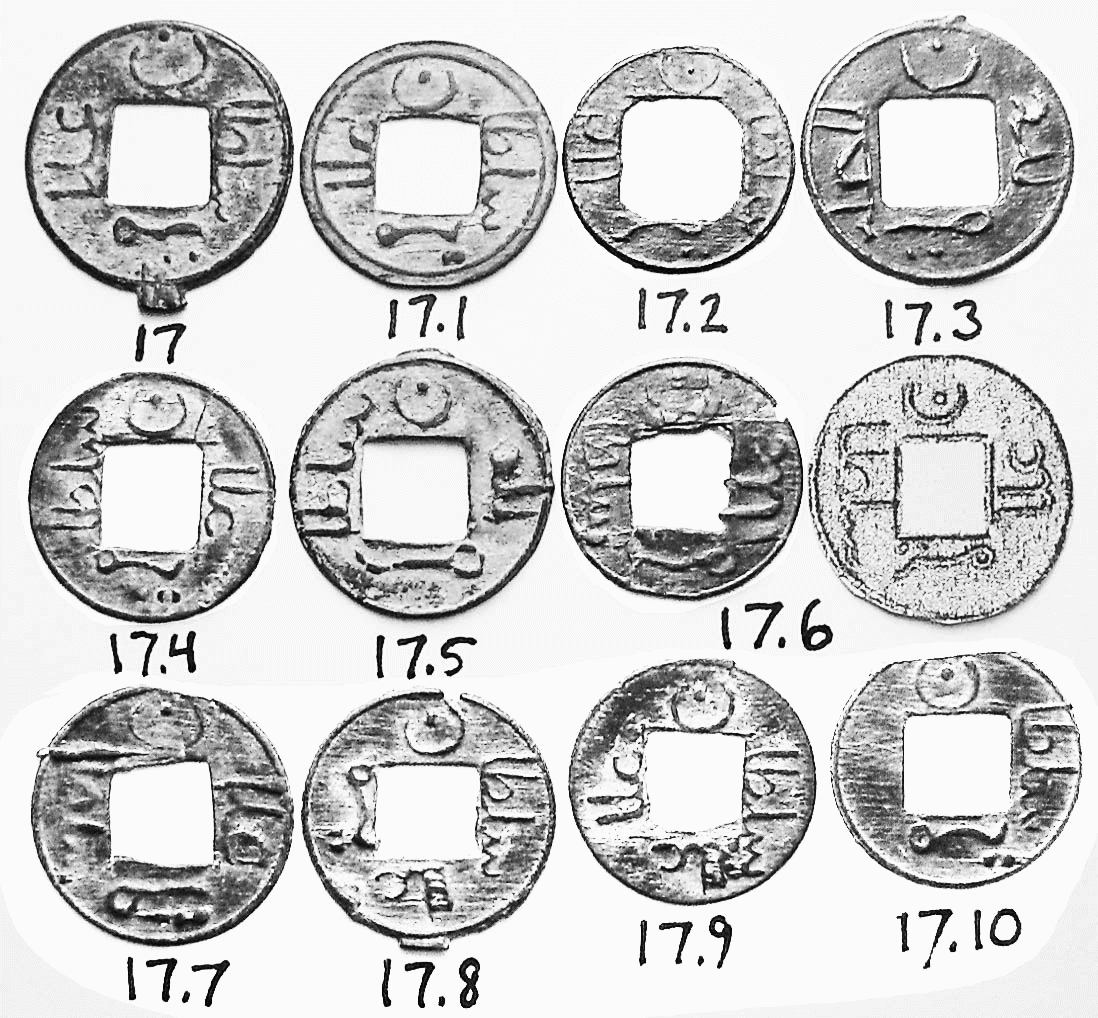
18
As Type 17 but round central hole, 19-20 mm, R4, but much rarer in
passable condition.
18.1
17-18 mm with large central hole, characters very shallow and weak,
R9
18.2
Right and left characters switched & inverted, 20 mm, R9
19 This is not actually a Palembang coin, but is being included because it has sometimes been wrongly so attributed and also, indeed, a fair number of these did turn up in the Palembang river hoards. The coin is from the Demak Sultanate, on Java, of Pangeran al-Patah, 1475-1518; 19 mm
